
The University of Colombo is a public research university located primarily in Colombo, Sri Lanka. It is the oldest institution of modern higher education in Sri Lanka. Specialised in the fields of natural, social, and applied sciences as well as mathematics, computer sciences, and law. It is ranked among the top 10 universities in South Asia.
Ragging is the term used for the so-called "initiation ritual" practiced in higher education institutions in India, Pakistan, Bangladesh, and Sri Lanka. The practice is similar to hazing in North America, fagging in the UK, bizutage in France, praxe in Portugal, and other similar practices in educational institutions across the world. Ragging involves abuse, humiliation, or harassment of new entrants or junior students by the senior students. It often takes a malignant form wherein the newcomers may be subjected to psychological or physical torture. In 2009, the University Grants Commission of India imposed regulations upon Indian universities to help curb ragging and launched a toll-free 'anti-ragging helpline'.
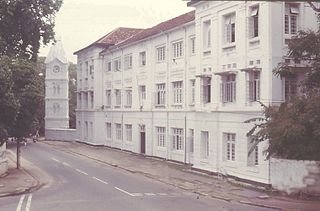
Ceylon Medical College was a public medical school in Ceylon. The college was established in 1870 as the Colombo Medical School. The college was based in Colombo. The college was merged with Ceylon University College in 1942 to form the University of Ceylon. The medical college became the university's faculty of medicine. The college was also known as Colombo Medical College.

Education in Sri Lanka has a long history that dates back two millennia. While the Constitution of Sri Lanka does not provide free education as a fundamental right, the constitution mentions that 'the complete eradication of illiteracy and the assurance to all persons of the right to universal and equal access to education at all levels" in its section on directive principles of state policy at (27. Sri Lanka's population had an adult literacy rate of 96.3% in 2015, which is above average by world and regional standards. Computer literacy in 2017 28.3% and phone users in 2017 105%, website users 32% in 2017. Education plays a major part in the life and culture of the country, which dates back to 543 BC. Sri Lanka's modern educational system modeled after Christian missionary system was brought about by its integration into the British Empire in the 19th century. Education currently falls under the control of both the Central Government and the Provincial Councils, with some responsibilities lying with the Central Government and the Provincial Council having autonomy for others. Education institutions with a tradition dating back to 5 BC are largely ignored by the state.

The University of Peradeniya is a public university in Sri Lanka, funded by the University Grants Commission. It is the largest university in Sri Lanka, which was originally established as the University of Ceylon in 1942. The university was officially opened on 20 April 1954, in the presence of Queen Elizabeth II, by Prince Philip, Duke of Edinburgh.

University Grants Commission is the body responsible for funding most of the State Universities in Sri Lanka, and operates within the frame work of the Universities Act No. 16 of 1978. A public organisation, established under the Parliament Act No 16 of 1978. Location is at No 20, Ward Place Colombo 07.
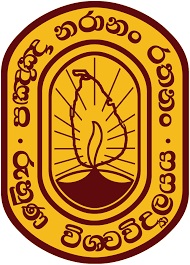
The University of Ruhuna is a public university in Matara, Sri Lanka.
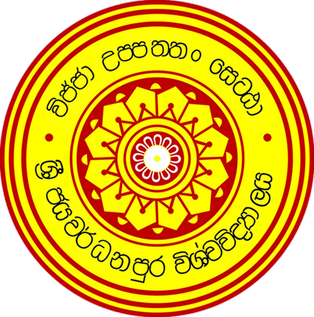
The University of Sri Jayewardenepura is a public university in Sri Lanka. It is in Gangodawila, Nugegoda, near Sri Jayewardenepura Kotte, the country's administrative capital. It was formed in 1958 from the Vidyodaya Pirivena, a Buddhist educational centre which was founded in 1873 by Hikkaduwe Sri Sumangala Thera.
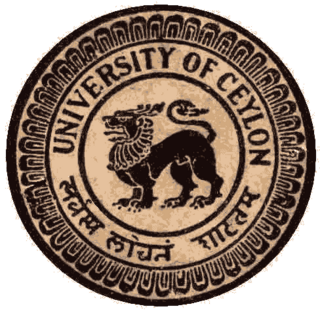
The University of Ceylon was the only university in Sri Lanka from 1942 until 1972. It had several constituent campuses at various locations around Sri Lanka. The University of Ceylon Act No. 1 of 1972, replaced it with the University of Sri Lanka which existed from 1973 to 1978. In 1978 it was separated into four independent universities. These are the University of Colombo, the University of Peradeniya, University of Kelaniya and the University of Sri Jayawardanapura.
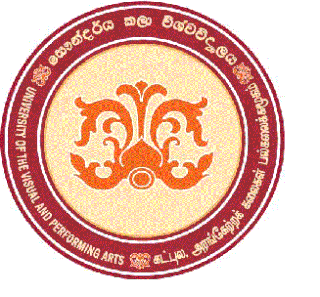
University of the Visual and Performing Arts (UVPA) is a public university located primarily in Colombo, Sri Lanka, specialising in art, design, fashion and the performing arts. It was formerly known as the Government College of Fine Arts, Heywood Institute of Art and the Institute of Aesthetic Studies of the University of Ceylon. It has no known date of foundation, but there is evidence of teaching as far back as 1893. It is the only university in Sri Lanka to exclusively offer special degree programs in visual and performing arts.
The University of Sri Lanka was the public university system of Sri Lanka from 1972 to 1978. The university system was dissolved in 1978 and its six campuses turned into independent universities: the University of Peradeniya, the University of Colombo, the University of Sri Jayewardenepura, the University of Kelaniya, the University of Moratuwa, and the University of Jaffna.

The South Asian Institute of Technology and Medicine (SAITM) is a privately owned educational institution providing higher education in Sri Lanka. It is recognised as a degree awarding institute under section 25A of the Universities Act No. 16 of 1978. In 2018, the parliament of Sri Lanka passed a special provisions act to abolish SAITM Medical faculty and to transfer the students to General Sir John Kotelawala Defence University.

The University of Jaffna is a public university in Jaffna, Sri Lanka. Established in 1974 as the sixth campus of the University of Sri Lanka, it became an independent, autonomous university in 1979.

The Faculty of Engineering, University of Peradeniya is one of the eight academic faculties at the university. It is the oldest engineering faculty in Sri Lanka. It offers full-time Undergraduate Courses leading to the degree of Bachelor of Science of engineering (B.Sc.Eng.), and several postgraduate degrees.

Ceylon University College was a public university college in Ceylon. Established in 1921, it was Ceylon's first attempt at university education. The college didn't award degrees under its own name but prepared students to sit the University of London's external examination. The college was based in Colombo. The college was merged with Ceylon Medical College in 1942 to form the University of Ceylon. The college was also known as University College, Ceylon; University College, Colombo; and Colombo University College. Its buildings and grounds are now occupied by the University of Colombo which is considered its successor.
The University of Colombo currently has seven faculties with 41 academic departments and two interdependent schools with five academic departments. All faculties and schools carries out courses of study and research in both graduate and undergraduate studies. In addition, the university has several institutions that specialize in different areas of research.

Inter-University Students' Federation is a confederation of students' unions across Sri Lanka. Around 70 students' unions are affiliated with the confederation, accounting for more than 95% of all higher and further education unions in Sri Lanka. The IUSF is the organization that is given leadership to whole university students in Sri Lanka. It is the largest student organization in Sri Lanka to date. It represents the voice of student councils and action committees in 15 higher education institutes including all major universities and technical colleges in Sri Lanka.
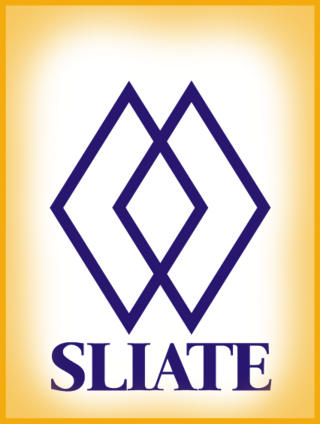
The Sri Lanka Institute of Advanced Technological Education is a statutory body in Sri Lanka coming under the purview of the Higher Education Ministry and offering Higher National Diploma courses. At present, it manages and supervises eighteen provincial Advanced Technological Institutes throughout the island. The institute is traditionally known for its education in the accountancy and engineering. As per the recommendations of the Committee appointed by Prof. Wiswa Waranapala, Deputy Minister of Higher Education in 1994, the Sri Lanka Institute of Advanced Technical Education (SLIATE) was formed in 1995, under the Sri Lanka Institute of Advanced Technical Education Act No. 29 of 1995. In 2001, the name of the institution was amended as Sri Lanka Institute of Advanced Technological Education (SLIATE).
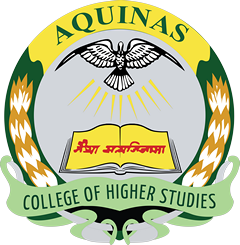
The Aquinas College of Higher Studies also known as Aquinas University College is a Sri Lankan nonprofit private Tertiary education institute that provides both academic degrees and vocational training.















